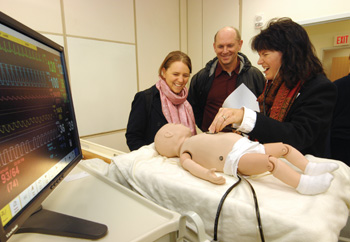
Tina Hartert, M.D.
Birthday may play role in asthma risk
Children who are born four months before the peak of cold and flu season have a greater risk of developing childhood asthma than children born at any other time of year, according to new research from Vanderbilt Medical Center.
In the Tennessee Asthma Bronchiolitis Study (TABS), which involved an analysis of the birth and medical records of more than 95,000 children and their mothers, researchers addressed the question of whether winter respiratory viral infections during infancy cause asthma.
They asked if there is a relationship between winter virus circulation (cold and flu season) during infancy, timing of birth, and the development of childhood asthma.
They found that the timing of when a child is born in relationship to the annual cold and flu season alters the risk for developing asthma.
Autumn-born babies, who are about 4 months old when the winter virus season peaks, have a nearly 30 percent increased risk of developing asthma compared with births during other times of the year, and this risk was similar to or greater than other well-established risk factors for asthma.
The research, conducted by post doctoral fellow Pingsheng Wu, Ph.D., and colleagues, appears in the American Journal of Respiratory and Critical Care Medicine.
“This holds promise for asthma prevention — as this evidence suggests that avoiding these early respiratory infections during infancy may have long-term as well as short-term benefits,” said Tina Hartert, M.D., associate professor of Medicine, Allergy, Pulmonary and Critical Care Medicine and director of the Center for Asthma Research at Vanderbilt.
“This is the first step; we now have to prove that preventing respiratory infections, such as respiratory syncytial virus (RSV), the most common virus causing severe respiratory infections during infancy, prevents a common lifelong chronic disease that in most cases begins in childhood.
“RSV always peaks in the winter. Over the course of the study, if the peak of RSV occurred in December, the highest rates of asthma were seen in August-born babies. If the peak was in February, the highest rates of asthma were seen in October-born babies, and that's exactly what we saw — nearly to the day,” Hartert said.
The researchers propose two possible explanations for the link: one, that there is a genetic susceptibility common to both bronchiolitis and the development of asthma; and two, that an environmental exposure such as a winter viral infection causes asthma.
Avoiding winter viruses is difficult, as is evidenced by the fact that 70 percent of infants are infected with RSV in their first year of life, and 100 percent by age 2.
For families whose infants are at high risk for developing asthma, avoiding infection through administration of a vaccine (if we had one), immunoprophylaxis, or timing of birth in the spring months, could be protective.
“These strategies hold the hope for asthma prevention. However, it's premature to make such recommendations until these interventions are tested and we prove that they work to prevent childhood asthma.”













